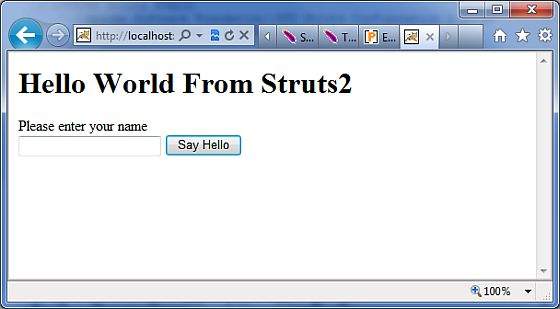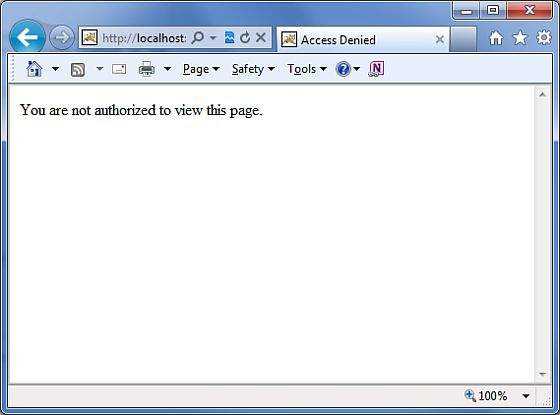
- Struts2 - Home
- Struts2 - Basic MVC Architecture
- Struts2 - Overview
- Struts2 - Environment Setup
- Struts2 - Architecture
- Struts2 - Examples
- Struts2 - Configuration
- Struts2 - Actions
- Struts2 - Interceptors
- Struts2 - Result Types
- Struts2 - Value Stack/OGNL
- Struts2 - File Uploads
- Struts2 - Database Access
- Struts2 - Sending Email
- Struts2 - Validations
- Struts2 - Localization
- Struts2 - Type Conversion
- Struts2 - Themes/Templates
- Struts2 - Exception Handling
- Struts2 - Annotations
- Struts 2 Integrations
- Struts2 - Spring
- Struts2 - Tiles
- Struts2 - Hibernate
- Struts 2 Useful Resources
- Struts2 - Questions and Answers
- Struts2 - Quick Guide
- Struts2 - Useful Resources
- Struts2 - Discussion
Struts 2 - Actions
Actions are the core of the Struts2 framework, as they are for any MVC (Model View Controller) framework. Each URL is mapped to a specific action, which provides the processing logic which is necessary to service the request from the user.
But the action also serves in two other important capacities. Firstly, the action plays an important role in the transfer of data from the request through to the view, whether its a JSP or other type of result. Secondly, the action must assist the framework in determining which result should render the view that will be returned in the response to the request.
Create Action
The only requirement for actions in Struts2 is that there must be one noargument method that returns either a String or Result object and must be a POJO. If the no-argument method is not specified, the default behavior is to use the execute() method.
Optionally you can extend the ActionSupport class which implements six interfaces including Action interface. The Action interface is as follows −
public interface Action {
public static final String SUCCESS = "success";
public static final String NONE = "none";
public static final String ERROR = "error";
public static final String INPUT = "input";
public static final String LOGIN = "login";
public String execute() throws Exception;
}
Let us take a look at the action method in the Hello World example −
package com.tutorialspoint.struts2;
public class HelloWorldAction {
private String name;
public String execute() throws Exception {
return "success";
}
public String getName() {
return name;
}
public void setName(String name) {
this.name = name;
}
}
To illustrate the point that the action method controls the view, let us make the following change to the execute method and extend the class ActionSupport as follows −
package com.tutorialspoint.struts2;
import com.opensymphony.xwork2.ActionSupport;
public class HelloWorldAction extends ActionSupport {
private String name;
public String execute() throws Exception {
if ("SECRET".equals(name)) {
return SUCCESS;
} else {
return ERROR;
}
}
public String getName() {
return name;
}
public void setName(String name) {
this.name = name;
}
}
In this example, we have some logic in the execute method to look at the name attribute. If the attribute equals to the string "SECRET", we return SUCCESS as the result otherwise we return ERROR as the result. Because we have extended ActionSupport, so we can use String constants SUCCESS and ERROR. Now, let us modify our struts.xml file as follows −
<?xml version = "1.0" Encoding = "UTF-8"?>
<!DOCTYPE struts PUBLIC
"-//Apache Software Foundation//DTD Struts Configuration 2.0//EN"
"http://struts.apache.org/dtds/struts-2.0.dtd">
<struts>
<constant name = "struts.devMode" value = "true" />
<package name = "helloworld" extends = "struts-default">
<action name = "hello"
class = "com.tutorialspoint.struts2.HelloWorldAction"
method = "execute">
<result name = "success">/HelloWorld.jsp</result>
<result name = "error">/AccessDenied.jsp</result>
</action>
</package>
</struts>
Create a View
Let us create the below jsp file HelloWorld.jsp in the WebContent folder in your eclipse project. To do this, right click on the WebContent folder in the project explorer and select New >JSP File. This file will be called in case return result is SUCCESS which is a String constant "success" as defined in Action interface −
<%@ page contentType = "text/html; charset = UTF-8" %>
<%@ taglib prefix = "s" uri = "/struts-tags" %>
<html>
<head>
<title>Hello World</title>
</head>
<body>
Hello World, <s:property value = "name"/>
</body>
</html>
Following is the file which will be invoked by the framework in case action result is ERROR which is equal to String constant "error". Following is the content of AccessDenied.jsp
<%@ page contentType = "text/html; charset = UTF-8" %>
<%@ taglib prefix = "s" uri = "/struts-tags" %>
<html>
<head>
<title>Access Denied</title>
</head>
<body>
You are not authorized to view this page.
</body>
</html>
We also need to create index.jsp in the WebContent folder. This file will serve as the initial action URL where the user can click to tell the Struts 2 framework to call the executemethod of the HelloWorldAction class and render the HelloWorld.jsp view.
<%@ page language = "java" contentType = "text/html; charset = ISO-8859-1"
pageEncoding = "ISO-8859-1"%>
<%@ taglib prefix = "s" uri = "/struts-tags"%>
<!DOCTYPE html PUBLIC "-//W3C//DTD HTML 4.01 Transitional//EN"
"http://www.w3.org/TR/html4/loose.dtd">
<html>
<head>
<title>Hello World</title>
</head>
<body>
<h1>Hello World From Struts2</h1>
<form action = "hello">
<label for = "name">Please enter your name</label><br/>
<input type = "text" name = "name"/>
<input type = "submit" value = "Say Hello"/>
</form>
</body>
</html>
That's it, there is no change required for web.xml file, so let us use the same web.xml which we had created in Examples chapter. Now, we are ready to run our Hello World application using Struts 2 framework.
Execute the Application
Right click on the project name and click Export > WAR File to create a War file. Then deploy this WAR in the Tomcat's webapps directory. Finally, start Tomcat server and try to access URL http://localhost:8080/HelloWorldStruts2/index.jsp. This will give you following screen −

Let us enter a word as "SECRET" and you should see the following page −

Now enter any word other than "SECRET" and you should see the following page −

Create Multiple Actions
You will frequently define more than one actions to handle different requests and to provide different URLs to the users, accordingly you will define different classes as defined below −
package com.tutorialspoint.struts2;
import com.opensymphony.xwork2.ActionSupport;
class MyAction extends ActionSupport {
public static String GOOD = SUCCESS;
public static String BAD = ERROR;
}
public class HelloWorld extends ActionSupport {
...
public String execute() {
if ("SECRET".equals(name)) return MyAction.GOOD;
return MyAction.BAD;
}
...
}
public class SomeOtherClass extends ActionSupport {
...
public String execute() {
return MyAction.GOOD;
}
...
}
You will configure these actions in struts.xml file as follows −
<?xml version = "1.0" Encoding = "UTF-8"?>
<!DOCTYPE struts PUBLIC
"-//Apache Software Foundation//DTD Struts Configuration 2.0//EN"
"http://struts.apache.org/dtds/struts-2.0.dtd">
<struts>
<constant name = "struts.devMode" value = "true" />
<package name = "helloworld" extends = "struts-default">
<action name = "hello"
class = "com.tutorialspoint.struts2.HelloWorld"
method = "execute">
<result name = "success">/HelloWorld.jsp</result>
<result name = "error">/AccessDenied.jsp</result>
</action>
<action name = "something"
class = "com.tutorialspoint.struts2.SomeOtherClass"
method = "execute">
<result name = "success">/Something.jsp</result>
<result name = "error">/AccessDenied.jsp</result>
</action>
</package>
</struts>
As you can see in the above hypothetical example, the action results SUCCESS and ERRORs are duplicated.
To get around this issue, it is suggested that you create a class which contains the result outcomes.